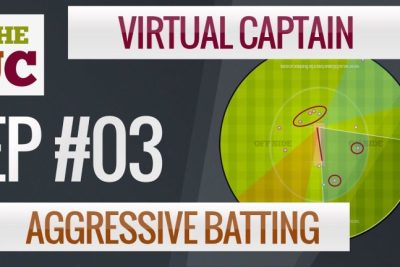Cricket, a sport known for its strategic gameplay, often relies on tactical field placements to gain an advantage over the opposition. These carefully crafted formations can make or break a team’s chances of success on the field. From close-in fielders to wide-spread outfielders, each placement serves a purpose, aiming to trap the batsmen or limit their scoring opportunities. In this article, we delve into the world of tactical field placements in cricket, exploring the art behind the game and uncovering the secrets to outsmarting the opponent.
In cricket, where should one position their best fielder?
In the game of cricket, placing your best fielder strategically is crucial for the team’s success. When it comes to determining the ideal position, the point fielding position stands out as the go-to choice. This is where you will typically find the team’s best fielder, ready to showcase their exceptional skills and agility. The point position demands quick reflexes and the ability to make swift decisions, making it the perfect spot for your top fielder to excel.
The point fielding position in cricket is often regarded as the hot spot for fielding prowess. This is where the best fielder shines, displaying their impeccable athleticism and sharp instincts. As the point fielder, they have the responsibility of stopping hard-hitting shots and swiftly returning the ball to the wicketkeeper or the bowler. With their exceptional fielding abilities, the best fielder at point can make game-changing catches and run-outs, significantly impacting the outcome of the match.
Placing your best fielder at point can be a game-changer in cricket. This position requires exceptional fielding skills, as the fielder needs to react swiftly to the batsman’s shots, whether they are defensive or aggressive. Fielding at point allows the best fielder to make diving catches, stunning stops, and quick throws, putting pressure on the opposition and boosting the team’s morale. Moreover, their presence at point can often intimidate the opposition batsmen, making them more cautious and prone to taking fewer risks.
In conclusion, placing your best fielder at point in cricket is a strategic move that can greatly impact the team’s performance. This position demands top-notch fielding skills, quick reflexes, and the ability to make game-changing catches and run-outs. By fielding their best player at point, a team can gain a competitive edge, increase the chances of getting crucial wickets, and create an atmosphere of intimidation for the opposition batsmen.
What does field placement mean in cricket?
Field placement in cricket refers to the strategic positioning of fielders on the playing field. However, there are certain restrictions that govern this placement. One key rule states that no fielder is allowed to stand on or have any part of their body over the pitch, which is the central strip between the wickets. These limitations ensure fair play and prevent any interference with the delivery of the ball.
The rules of field placement in cricket are designed to create a balanced and fair playing field. When the ball is bowled, fielders have the freedom to position themselves anywhere on the field. However, they must adhere to the restriction that prohibits them from standing on or having any body part over the pitch. This regulation ensures that the bowler’s delivery is not hindered and maintains the integrity of the game. By carefully strategizing their field placement within these constraints, teams aim to maximize their defensive capabilities and increase their chances of taking wickets.
What positions are there in cricket for attacking on the field?
In cricket, the attacking field positions play a crucial role in taking wickets. One such position is the slip cordon, where fielders stand close to the batsman, ready to catch an edge off the bat. This high-pressure position requires excellent reflexes and concentration to make crucial breakthroughs.
Another attacking position is the silly point, located just behind the batsman on the off side. This fielder’s role is to closely observe the batsman’s movements and react quickly to any potential scoring opportunities. By applying constant pressure, the silly point aims to unsettle the batsman and force mistakes.
Short leg is yet another attacking position, positioned close to the batsman on the leg side. The fielder at short leg must be prepared for fast-paced deliveries and be ready to react instantly to any shots played in their direction. This position is often considered dangerous due to the proximity to the batsman, making it an ideal spot to induce errors.
These attacking field positions create an aura of aggression and pressure on the batting side. With fielders strategically stationed close to the batsman, the aim is to create opportunities for wickets. By combining skillful fielding with accurate bowling, these positions contribute significantly to a team’s success in the game of cricket.
Strategic Tactics Unveiled: Elevate Your Field Placements in Cricket
Looking to take your field placements in cricket to the next level? Unlock the strategic tactics that will elevate your game with precision and finesse. With a keen understanding of the field dynamics and player strengths, you can strategically position your fielders to maximize your team’s success. Whether it’s a well-placed slip or a deep square leg, every fielder has a crucial role to play in creating pressure on the opposition. So, embrace the power of strategic field placements and watch your team dominate the game like never before.
Mastering the art of field placements is the key to outsmarting your opponents and gaining a competitive edge in cricket. By carefully analyzing the strengths and weaknesses of your team and the opposition, you can strategically position your fielders to exploit every possible opportunity. From close-in fielders for spin bowlers to the outfielders who patrol the boundaries, each player’s position is a tactical decision that can make or break the game. So, equip yourself with the knowledge of strategic tactics and elevate your field placements to become a force to be reckoned with in the world of cricket.
Unleash Your Cricket Mastery: Proven Strategies for Tactical Field Placements
Are you ready to take your cricket skills to the next level? Unleash your cricket mastery with our proven strategies for tactical field placements. Whether you’re a seasoned player or just starting out, our expert tactics will help you dominate the game like never before.
With our strategic field placement techniques, you’ll have the power to outsmart your opponents and control the flow of the game. From setting up the perfect field to exploit your opponent’s weaknesses, to creating pressure and taking crucial wickets, our strategies will give you the edge you need to become a true cricket master. Don’t let your opponents dictate the game – take charge and show off your tactical prowess with our proven field placement strategies. Unleash your cricket mastery and leave your mark on the field.
In the dynamic world of cricket, tactical field placements play a pivotal role in determining the outcome of a match. With strategic positioning, captains and coaches can effectively counter the opposition’s batting strengths and seize crucial wickets. By deploying fielders in key areas, such as close-in catchers or boundary riders, teams can apply pressure on the batsmen and disrupt their rhythm. These calculated fielding tactics not only enhance a team’s defensive capabilities but also create opportunities for game-changing moments. In the ever-evolving game of cricket, mastering the art of tactical field placements is an essential skill that can make all the difference between triumph and defeat.


